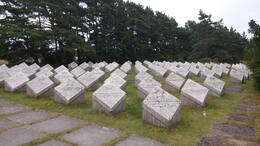Naktinis Tehumardi mūšis
Spalio 8-osios vakarą, tamsoje, netoli Tehumardi kaimo susitiko artėjantys sovietų ir besitraukiantys vokiečių kariai.
1944 m. spalio 8 d., sutemus, besitraukiantys vokiečių daliniai susidūrė su artėjančiais Raudonosios armijos daliniais.
Prieštankinių dalinių, vadovaujamų majoro Vladimiro Millerio, abiejose kelio pusėse buvo įsikūrę stovyklavietės prieš pat grenadierių bataliono, vadovaujamo kapitono Klauso Ritterio, atvykimą iš Kuresarės, lydimą prieštankinių dalinių, judančių Salmės link.
Kapitonas Ritteris prisimena:
„Nujaučiau, kad priešas įsitaisęs kelio atkarpoje priekyje. Atsižvelgdamas į tai, daviau kolonai konkrečius įsakymus ir nurodymus. Tikslas buvo kuo tyliau ir nepastebimai juos aplenkti, kad pasiektume kitą Salmės upės pusę. Mūsų pačių kariai jau buvo ten gynybinėse pozicijose. Nurodžiau, kad jie galėtų pradėti šaudyti tik tuo atveju, jei aš tai padarysiu pirmas. Taigi mes judėjome toliau, kol, prieš pat pasiekdami upę, atsidūrėme pačiame priešo stovyklos viduryje.“
Vietos gyventoja Hermiine Saar prisimena:
„Tą vakarą, 8 valandą, visus čia, Tehumardi mieste, staiga apkurtino šūvių aidėjimai, lydimi garsių riksmų ir šūksnių. Į orą buvo šaudomos baltos ir žalios signalinės raketos.“
Kapitonas Klausas Ritteris tęsia: „Judėdami per stovyklos centrą, pastebėjome keturis priešo T-34 tankus, dundančius kairėje kelio pusėje. Tankų inžinieriai, pastebėję mažą amerikiečių trofėjinį tanką priešais mūsų koloną su nupieštais kryžiais, pradėjo jį taranuoti. Vairuotojas nedelsdamas įjungė atbulinę pavarą. Tankas pervažiavo ir sutriuškino už jo esantį tanką, sklindant baisiems riksmams ir klyksmams. Aš atidengiau ugnį. Tada visa kolona pradėjo šaudyti į priešą, į kairę ir į dešinę. Mes pradėjome bėgti. Tiesiog stengėmės kuo greičiau praeiti pro stovyklą.“
Fjodoras Paulmannas savo memuaruose „Ugnis ir manevras“ prisimena: „Mūsų vyrai taranavo tanką kolonos priekyje. Šis apvirto, sustojo ir užsidegė. Kariniai sunkvežimiai įvažiavo tiesiai į liepsnojantį tanką. Kilo visiškas chaosas. Kelias buvo užblokuotas. Mūsų lengvieji tankai ir savaeigė artilerija apšaudė koloną, jų sviediniai sprogo visoje rikiuotėje. Daug technikos sudegė... Mūšio laukas Tehumardi drebėjo nuo chaotiškų nežmoniškų garsų aidų.“
Kapitonas Hermanas Ulrichsas prisimena: „Arkliai šuoliavo, vyrai bėgo... Visi norėjo iš ten ištrūkti ir pereiti tiltą per kanalą iš Saremos į Servės pusiasalį.“
Rytą Tehumardis atrodė šiurpus vaizdas. Aplinkui buvo išsibarstę šimtai žuvusių sovietų ir vokiečių kareivių. Tiksli įvykių grandinė ir aukų skaičius iki šiol nežinomi.
Manoma, kad priešas prarado iki 500 vyrų.
1. Estijos paveldo tarybos kultūros paminklų registras. Karinis paveldas. https://www.register.muinas.ee
2. Vendel, Fred. 1944 m. ruduo. Mūšiai Vakarų Estijos salose ir Servėje. Talinas, 2020.
Jūsų komentarai
Susijusios vietos
Tehumardi naktinio mūšio paminklas
Antrojo pasaulinio karo metu, 1944 m. spalio 8 d., 20 val. vakare, Raudonoji armija susirėmė su besitraukiančiais vokiečių kariais Tehumardi kaime, Servėje. Mūšis įvyko 18-ajame Kuresarės-Serės kelio kilometre.
Netoliese, 1966 m., buvo atidengtas paminklas, tuo pačiu metu atidarytos Raudonosios armijos kapinės, skirtos konfrontacijai atminti. 21 metro aukščio paminklas vaizduoja betoninį kardą, kurio kryžiaus apsauga papuošta kareivių veidais. Ant kryžiaus apsaugos estų ir rusų kalbomis iškaltas užrašas: „1941–1945. Sovietų kareiviams ir Saremos gynėjams bei išvaduotojams“. Tehumardi kapinėse yra 90 dolomito lentelių, kuriose išgraviruoti žuvusių Raudonosios armijos kareivių vardai.
Už poros šimtų metrų nuo kapinių, palei kelią Sõrvės link, dešinėje kelio pusėje stovi didelis granito paminklas. Jis buvo atidengtas 2012 m. liepos 15 d. ir pastatytas apytikslėje mūšio vietoje. Ant paminklo yra lentelė su užrašu: „Čia 1944 m. spalio 8 d. įvyko Tehumardi naktinis mūšis.“
Tehumardi kapinės buvo pašalintos 2024 m., tačiau memorialinis stulpas išliko, nors dalis teksto yra iš dalies uždengtas.






Jaunystėje (dabar man 67 metai) pažinojau to mūšio dalyvį Nikolajų (visi jį vadino Kolia) Rosmanną. Kartais Kolya prisimindavo šias žudynes (pasak Kolios, kitaip to nepavadinsi), kai buvo girtas. Jie pjovė ir sumušė priešą aklinoje tamsoje, atpažindami jį iš prisilietimo, pagal plaukus: jei jis buvo plika galva, vadinasi, jis buvo vienas iš mūsų; jei jis buvo apsikirpęs, vadinasi, buvo vokietis, imk! Mūšio lauke skambėjo šūksniai ir keiksmai estų ir vokiečių kalbomis, sužeistųjų dejonės, šaudymas, bet dažniausiai kova rankomis. Nugalėjo estai. Kolya taip pat prisiminė tokias smulkmenas, kaip tamsoje jo ranka netyčia įkrito į vokiečio palto kišenę, ten buvo armonika, mes susimušėme su šiuo vokiečiu, ir aš jį sumušiau. Kolya nenurodė, kaip tiksliai jis tai padarė.